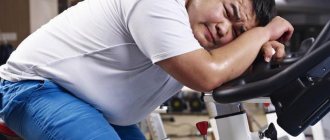The more humanity develops, the less need there is for physical labor. The overwhelming majority of modern people engaged in intellectual work are constantly at the computer, and when they come home, they sit down at the TV or again at the computer. It seems that everything is logical, a comfortable life is ensured, but why does a sedentary lifestyle negatively affect health? Fewer and fewer people can boast of unlimited energy, no headaches, no back pain.
In fact, the human body is designed to withstand static and even long-term loads. If they are not there, and the body is in a constant sitting position, problems begin. Muscles lose their elasticity, atrophy, blood circulation slows down, and weight only increases. This is a natural reaction of a living organism to the lack of opportunity to burn calories.
How to determine if you are at risk?
It is enough to simply determine whether you will have problems with a sedentary lifestyle in the near future. If these statements are true for you, then you are at risk:
- Spend about 6-7 hours in a sitting position at your workplace;
- take breaks very rarely;
- you practically don’t move on foot;
- you get to work and home by your own vehicle or convenient public transport;
- do not walk up the stairs, move only by elevator;
- you prefer passive relaxation: going to the movies, watching TV shows, and so on;
- additional activities or hobbies also involve sitting;
- you don't play any sports.
And the easiest way to check is to observe yourself for one day, and if you spend 7 or more hours sitting, you automatically fall into the risk group.
There is an obvious solution!
A sedentary lifestyle can be combated through sports training.
The choice of sport and intensity depends on your passions, abilities, health and schedule. Here we are powerless to give universal advice. But any physical activity will benefit a person who loves a sedentary lifestyle.
However, sports is too obvious advice. Yes, training is not a panacea. After all, sitting in an office chair for eight hours a day is a very harmful pastime. But you can fight this. A natural question arises: how?
Diseases of the musculoskeletal system
The most common consequence of a sedentary lifestyle is problems with the spine. These are pain in the lower back, cervical spine, scoliosis and curvature. Over time, osteochondrosis develops, limited motor function, and pain in the lower and upper extremities appear. Sprains, dislocations, and even fractures often occur.
This problem arises against the background of leaching of calcium from the bones. The muscles weaken and decrease in volume, and the condition of the ligamentous apparatus worsens.
Changes definitely occur in the joints; they become inflamed because they do not perform their intended function. Today, problems with joints no longer occur in old age, but also appear in young people.
Problems with blood vessels and heart
What are the dangers of a sedentary lifestyle? It can cause the development of pathologies of the cardiovascular system. The heart muscle weakens so much that even a short run to the same tram causes the heart to work at its limit.
Rapid heartbeat occurs and tachycardia develops, which can cause arrhythmia. And all this can end in myocardial infarction.
Constant sitting causes pressure surges, and with persistently elevated blood pressure there is a huge risk of developing a stroke.
Excess weight
Another problem that inevitably arises with a sedentary lifestyle is obesity. Excess fat layer is essentially a “freeloader” for the body. Fat takes oxygen and nutrients from food from the body without giving anything in return.
Another consequence of a sedentary lifestyle is belly fat. The abdomen appears especially in men, but fat in this area is quite difficult to remove. In men, fat lies deep inside the body, mainly around the intestines, so getting rid of such a belly is quite difficult. As a result, heart problems and shortness of breath appear.
Inactivity from within
A sedentary lifestyle causes physical inactivity , which leads to problems with internal organs, and later to more serious diseases.
First of all, excessive perseverance directly affects the main muscle of our body - the heart. As the heart weakens, it makes less productive contractions, which contributes to a lack of vascular tone. The consequence is a slow metabolism and cellular oxygen deficiency. Such a series of events can very quickly lead to various pathologies.
Find out how to start working effectively; focus on work; work and get everything done; accomplish more and work less.
The joints also suffer greatly from lack of activity: diseases of the spine and the musculoskeletal system as a whole appear.
As you know, muscle mass does not disappear, but is hidden under fat, therefore, due to the lack of the ability to burn extra calories, the body quickly gains fat mass, and then obesity appears, which is a serious test for the liver, kidneys and, of course, the heart, and the muscles themselves are subject to dystrophy . Even minimal physical activity with such problems will be extremely difficult.
Video: the effect of inactivity on the body
https://youtu.be/XPrzleCeGRs
Did you know? It’s quite easy to burn the fat accumulated over the past year, but not many people can say goodbye to the fat mass of previous years. Fat has the property of becoming “woody”, and the body considers it habitual, which prevents it from being easily removed.
Changes in psychological state and headaches
What does a sedentary lifestyle lead to? Mental health problems appear. It means that without physical activity, the production of serotonin (the hormone of happiness) is reduced. And this inevitably leads to a depressive state, people constantly feel moral and physical fatigue, and are in a bad mood. Some people even have suicidal thoughts and have no sense of fulfillment. After all, there can be no question of any social activity if a person is in a depressed state and is only capable of solving his current everyday problems.
Modern people often experience nervous disorders, in particular chronic fatigue syndrome, which is accompanied by insomnia.
And, of course, if physical activity is reduced, then why not have headaches? After all, blood circulation is impaired, an insufficient amount of oxygen reaches the brain, hence the migraine and bad mood. How can you be in a good mood if you have a headache?
Daily caloric intake per day while sitting
Calories are units that measure the amount of heat received by the body from digested food. To avoid the accumulation of excess fat in the human body, there is a certain norm of kilocalorie consumption per day for different categories of people (the norm depends on gender, age, lifestyle).
So, the required number of kilocalories for women who lead a passive lifestyle:
- 19-25 years old - no more than 2000 kcal/day;
- 26-50 years old - 1800 kcal/day;
- 51 years and older - 1600 kcal/day.
Calories needed to maintain normal body fat in men :
- 19-30 years old - 2400 kcal/day;
- 31-50 years old - 2200 kcal/day;
- 51 years and older - no more than 2000 kcal/day.
Important! Even if you need to lose weight, you should not consume less than 1200 kilocalories per day. Such experiments can lead to gallbladder diseases, as well as heart problems.
Varicose veins and hemorrhoids
Due to the fact that a person moves little, he experiences stagnation of venous blood in the pelvis. And this is a direct path to the development of hemorrhoids.
Varicose veins are another scourge of modern man. If earlier it was believed that this disease was more characteristic of the female half of humanity, now it is often found in men. Varicose veins are dangerous due to the formation of blood clots, which at any time can clog the blood vessels leading to the lungs, heart muscle or brain.
The risk of developing varicose veins increases if a person has a genetic predisposition to this disease. A sitting position is especially harmful when the legs are stacked on top of each other, then the blood vessels are additionally compressed.
Health effects
As a result of a lack of physical activity, there is a likelihood of exacerbation and development of many diseases. Let's take a closer look at them.
Osteochondrosis
- a classic disease that affects almost all people leading a sedentary lifestyle. In a sitting position, the load on the spine increases, and a lack of physical activity leads to salt deposition. Blood circulation is impaired, intervertebral discs lose their ability to function fully. Without comprehensive treatment of osteochondrosis, the risk of intervertebral protrusions and hernias increases.
Headache
. With cervical osteochondrosis, cerebral circulation is impaired, resulting in headaches of varying intensity.
Diseases of the cardiovascular system
. Disruption of the metabolic process and decreased muscle tone, characteristic of a lack of physical activity, also negatively affects the functioning of the heart. Decreased tone and weak blood flow lead to stagnation and thickening of the blood, resulting in the formation of blood clots. At the same time, poor circulation leads to the destruction of triglycerides in the blood, which increases the risk of cholesterol plaques forming on the walls of blood vessels. These factors significantly increase the development of the following diseases:
- myocardial infarction;
- stroke;
- ischemic disease;
- cardiovascular failure;
- atherosclerosis.
Obesity
. A sedentary lifestyle contributes to metabolic disorders. Because of this, calories are not burned in sufficient quantities, resulting in excess weight. Extra pounds, combined with poor nutrition, poor environment and daily stress, turn into obesity. This pathology provokes a number of other diseases, for example:
- cardiovascular diseases
- hypertension;
- arthritis;
- diabetes mellitus and many others.
Phlebeurysm
. Sitting for a long time leads to impaired blood flow. This problem increases the risk of developing pathological processes in the veins, which are characterized by an increase in their length, expansion, and the formation of nodes and convolutions. Unpleasant symptoms of varicose veins, such as pain, swelling, cramps, can also lead to more serious consequences, namely the formation of blood clots. Deep vein thrombosis without appropriate treatment is life-threatening.
Fragility and brittleness of bones
. With a long-term sedentary lifestyle, bone tissue becomes more porous, bones lose strength, and their fragility and fragility increase. There is a high likelihood of developing osteoporosis.
Constipation
. Lack of physical activity negatively affects the functioning of intestinal motility. As a result, constipation may occur, which over time becomes chronic. In this aspect, nutrition also plays a significant role, so the problem needs to be addressed comprehensively.
Haemorrhoids
. Constipation often leads to more unpleasant consequences. Sitting in one position for a long time provokes the formation of nodes, which during periods of exacerbation will make themselves felt with severe pain, bleeding and other unpleasant symptoms. The main thing is to stop the development of the disease in the early stages, when it is still possible to get rid of it without surgical intervention.
Diseases of the genitourinary system
. Staying in a sitting position for a long time is fraught with stagnation of blood in the pelvic organs. This can cause the development of pathologies such as:
- prostatitis;
- infertility;
- nephritis.
Premature aging
– also often the result of a sedentary lifestyle. With age, the end sections of chromosomes—telomeres—shorten. However, with insufficient physical activity, this process occurs more rapidly. As a result, signs of aging appear early in the body.
Insomnia
. Lack of physical activity causes sleep problems. Our body mistakes prolonged sitting in a sitting position for rest, which results in insomnia.
Depression
. A lack of physical activity reduces the production of joy hormones – endorphin and serotonin. Insufficient levels of them in the body significantly increase the likelihood of developing mental disorders, such as depression.
Respiratory problems
Doctors have long noticed that the consequences of a sedentary lifestyle are frequent colds. And everything is connected with the fact that if physical activity is reduced, then the functional capacity of the lungs also decreases. During the respiratory act, special cells called “macrophages” are produced, which protect the alveoli from microbes. Their life cycle is short. Their number is sharply reduced if a person moves little and stays in a polluted room for a long time. Hence the conclusion is that in addition to a sedentary lifestyle, polluted office air poses a huge risk to the respiratory system. After all, macrophages quickly die from inhaled dust. In addition to dirty office air, the risk increases with smoking and constant inhalation of exhaust fumes from vehicles.
A person who moves little breathes shallowly, that is, all the alveoli of the lungs do not participate in the process. As a result, dead microphages are poorly removed and blood flow weakens. This creates unprotected areas of the alveoli, into which germs and viruses penetrate without any problems. Hence colds and lung diseases.
For people who move little, it is recommended to do breathing exercises, which will allow you to include the maximum number of alveoli in the process. And the most interesting thing is that the best breathing exercises are cheerful and cheerful laughter.
What other problems might arise?
The consequences of a sedentary lifestyle in women are stagnant processes in the pelvis, and these are problems with the uterus, appendages and other organs. In addition, both men and women may experience problems with the functioning of the gastrointestinal tract, a huge risk of developing diabetes mellitus and connective tissue hypertrophy.
Recent studies conducted by specialists from the University of California (USA) have proven that a sedentary lifestyle is directly related to the thinning of the area of the brain responsible for memory.
What to do?
The easiest and best way is to change your lifestyle. Although this is not always possible.
How to avoid the consequences of a sedentary lifestyle? You should follow some rules that will reduce the negative impact of a sedentary lifestyle.
Throughout your workday, try to take every opportunity to move. Set an alarm to remind you to stretch every 30 minutes.
For lunch, go to the furthest food establishment. If possible, play active games during breaks or do some exercise with your employees.
Don't deny yourself a visit to the gym or swimming pool. It is best to devote time to sports activities at least 2-3 times a week. If the office has an elevator, then refuse it, go down and up the stairs. Walk to and from work, at least a few stops. When you get home, don’t immediately sit down at the computer or TV. If you have children, go for a walk with them, or take the dog and go for a walk with it.
Yoga can help solve back problems. Sign up for a course of classes and don't miss them.
Don't be lazy, do gymnastic exercises for at least 10 minutes in the morning. On the weekends, also keep yourself active. A trip to nature is a great opportunity to combine relaxation and a game of badminton or ball.
If there are problems with the veins, then compression hosiery can act as a preventative measure. It is suitable for both healthy people and those with varicose veins at an early stage.
Constantly follow the path of reducing the amount of food you consume. Every year you grow older it will be harder and harder to get rid of the fat layer. Although you can fight obesity not only with the help of the gym, but also with healthy and passionate sex.
Exercises for a sedentary lifestyle
When all the tips and recommendations have been exhausted, although you can come up with a lot more, all that remains is to figure out which gymnastics at work with a sedentary lifestyle is optimal for your goals, and which exercises can be done at home.
At work: without leaving your desk
It is optimal to make such exercise your daily ritual. You shouldn’t be afraid or embarrassed by the puzzled looks of your colleagues, because it’s your health. If you do not take care of it today, then tomorrow it can present you with many unpleasant surprises. Therefore, uncomprehending glances are the least of evils.
- Sit back in your chair if it's fairly comfortable. Stretch both legs forward, and then alternately bend one or the other at the knee. It is important not to lower your feet to the floor, but to keep them suspended. 10-20 repetitions for each limb will be quite enough.
- Lower one leg, extend the other, and stretch your toes forward. Make circular movements first clockwise and then counterclockwise. Repeat with the other leg, 10-15 times for each is just enough.
- Rotate your shoulders first forward ten times and then back. Keep your back straight.
- Slowly rotate your head clockwise and then counterclockwise (it is better not to do this exercise if you have cervical osteochondrosis).
- Spread your arms out to the sides so that they form a horizontal line. Stretch up with the top of your head, while simultaneously bending one arm at the elbow, placing it behind your head, and touching the opposite shoulder. You need to perform 15-20 repetitions alternately with each hand, and then the same number with both.
- While sitting, tighten your buttock muscles as much as possible. Hold the position for a few seconds and then relax. Repeat 20-30 times.
- Place your palms in front of your chest, as if in a pleading gesture. Press them together forcefully, fix the position for 10-15 seconds, relax. Repeat up to 10 times.
- Clench and unclench your fists for a few seconds, then clasp your fingers and stretch upward.
- Lower your arms along your body and shake them.
- Moving slightly back from the table, lean your whole body forward, simultaneously bringing your shoulder blades together. 5-10 repetitions are enough.
- Sit on the very edge of an office chair or chair, straighten your back, pull in your stomach and tighten your abdominal muscles. This exercise must be repeated 40-50 times, otherwise it will not have any effect.
- As you inhale, sharply raise your shoulders, and as you exhale, quickly lower them. You need to do 10-15 repetitions.
- Sit with your feet completely flat on the floor, preferably taking off your shoes. Alternately lift your toes and heels off the floor. Repeat 20-30 times.
- Take a cylindrical object, for example, a glue stick, and roll it with your feet on the floor surface for 2-3 minutes.
Lastly, stretch your legs forward, lean forward as much as possible, while trying to reach your toes with your fingertips.
https://youtu.be/UNACJqyfxiA
At home
Since a sedentary lifestyle involves a lot of stress on the legs, spine, and internal organs, it’s not a bad idea to work out/stretch these areas during home workouts.
- Stand straight, feet shoulder-width apart, arms along your body. Slowly move your pelvis back while maintaining the natural curve in your back. In this case, your legs need to be slightly bent at the knees. It is assumed that you need to perform at least 40-60 repetitions.
- Take a wide step forward, as if in a lunge, so that your leg forms a sharp angle at the knee. Rotate your body in the opposite direction so that you feel the tension in the muscles in your hips. Return to the starting position. Repeat on each leg 15-20 times.
- While standing, perform the mill exercise, that is, alternately raise your outstretched arms over the front and lower them as much as possible in the opposite direction. You can do this any number of times for 3-5 minutes.
- Standing straight, feet shoulder-width apart, perform 20-25 swings back and forth and to the side. Repeat the same amount for both legs. In this case, you can keep your hands on your belt, or you can put them behind your head.
- As you exhale, bend your body forward without rounding your back or bending your legs, and as you inhale, return to your original position. The feet are shoulder-width apart and the hands are on the waist. Repeat 20-25 times.
- Raise your arms to a horizontal position, bend your elbows, palms in front of your chest, with the insides facing down. Make jerking movements, trying to bring your shoulder blades together as much as possible. At the same time, you can rotate the body left and right alternately.
These are basic movements that can be greatly varied if desired. For example, you can train yourself to always do morning exercises, go jogging regularly, and also choose any active activity of your choice. Many people play football, basketball, go to the pool, dance and practice martial arts. Everything here is very individual, the main thing is not to sit still during your free time from work, otherwise you will definitely not like the consequences.
https://youtu.be/vaM_VBbLWug
Diet
To reduce symptoms of physical inactivity and lose excess weight, it is recommended to eat on a schedule. No need to snack on chips and chocolates. Snacks on good food should be every 2-3 hours. Portions should be small. Look at your lunch taken from home - don’t be afraid, divide it into two, or better yet, three meals.
Avoid any foods that may cause excess weight or cellulite. These products include: smoked meats, fried poultry with skin, sweets and baked goods, full-fat sour cream, coffee, carbonated drinks and bananas. Healthy foods include: fresh and steamed vegetables, fruits, crumbly cereals, dried fruits, dairy products.
Before each meal, it is recommended to drink a glass of water or a cup of green tea, about 30 minutes before the meal. Water will fill your stomach without adding extra calories.
What a sedentary lifestyle
The “mobility” of a person’s lifestyle is calculated quite simply. If an individual moves for less than 30 minutes during the day, then, alas, this lifestyle is sedentary, and this is very dangerous for health and even the functioning of internal organs.
Did you know? The results of many studies have shown that every hour spent sitting takes 22 minutes from a person’s life, and 1.5 hours of not very intense cardio training (running, jumping) will add more than an hour to the total life expectancy.











